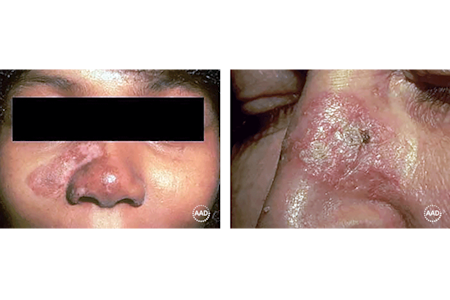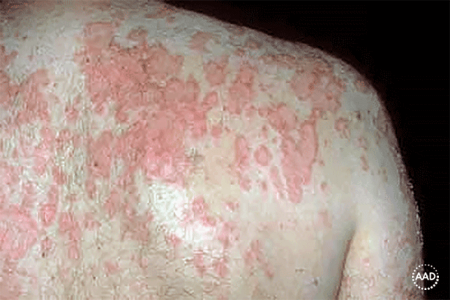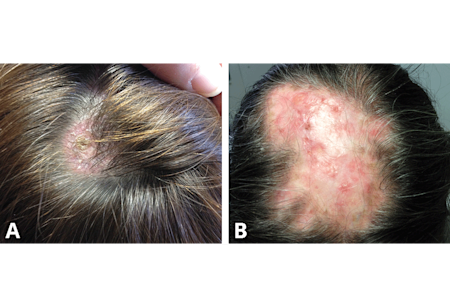Lupus and your skin: Signs and symptoms
Where do signs of lupus appear on the skin?
There are different types of lupus, and each can affect the skin differently. You may see a rash, sores, swelling, or other changes. These changes often appear on skin that gets sun like the:
Face
Lips
Scalp
Ears
Neck
Hands
Arms
Thighs
When lupus affects the skin, signs can also develop on skin that gets little, if any, sun like the:
Breasts
Buttocks
Back
Chest
Some people develop lupus sores inside their mouth, nose, or vagina.
Lupus can also affect your hair and nails
Hair loss, thinning hair, and nail changes are common in people who have different types of lupus.
The most common type of lupus, systemic lupus erythematosus (SLE), can cause dry, coarse hair to develop along the hairline. These dry, coarse hairs break off easily, causing the sparse-looking hair known as lupus hair.
Other types of hair loss also develop. People lose hair on their scalp, legs, eyebrows, eyelashes, or elsewhere. The hair loss may be patchy or widespread. With proper treatment for lupus, this lost hair often grows back.
If you have discoid lupus, hair loss can be permanent. Discoid lupus causes raised, scaly patches. As these patches clear, scars can form. When scars develop on the scalp, hair cannot grow where there are scars. Prompt treatment of discoid lupus on the scalp can prevent scarring.
When lupus affects the nails, it can cause:
Nails to crack or fall off
Discolored nails
Swelling around the nails
If you have discoid lupus and a darker skin tone, you may develop dark, blue-black nails.
What does lupus rash look like?
The following pictures show some of the many different rashes, sores, and other signs of lupus that can develop on the skin.
You’ll also see ways that lupus can affect the hair and nails.
Swollen eyelid(s) and swelling around one or both eyes
When lupus affects the skin, swelling can be one of the first signs of lupus. When this patient saw a dermatologist, the doctor immediately began testing for lupus. Treatment for lupus cleared her swelling and redness.

Butterfly rash (aka malar rash)
Occurring only in people who have lupus, this rash spreads out across the nose and cheeks, often in the shape of a butterfly. This itchy rash often appears after someone with SLE or acute cutaneous lupus spends time in the sun.

Thick, scaly patch of skin (discoid lupus)
People who have discoid lupus develop these patches. Most patches appear on the face, scalp, or ears, but patches can develop elsewhere on the skin. Without prompt treatment, these patches tend to stay on the skin for a long time — sometimes for years.

Dark spots, light spots, and scars (discoid lupus)
If you have a darker skin tone, the long-standing patches of discoid lupus will eventually clear and can leave behind dark spots (A), light spots, or permanent scars (B). Prompt treatment of the thick, scaly patches can prevent spots and permanent scarring.

Mouth sores (discoid lupus)
Discoid lupus can cause sores inside the mouth. People who have lupus can also develop sores inside their nose, eyes, or vagina. These sores can feel uncomfortable.

Scaly rash on sun-exposed skin (subacute cutaneous lupus)
Effective sun-protection helps to prevent this rash, which usually develops on the upper back, upper chest, or arms. It can be mistaken for psoriasis or eczema. The rash heals without causing scars, but it can leave areas of lighter skin.

Rash with a ring-like pattern (subacute cutaneous lupus)
Instead of developing a rash that looks like eczema or psoriasis, some people with this type of cutaneous lupus get a ring-like rash from the sun. A small percentage of people will develop both this ring-like rash and the one that looks like eczema or psoriasis.

Light-sensitive skin
Lupus can make your skin extremely sensitive to sunlight and other types of light. This patient developed a lupus rash after spending time under fluorescent lighting.

Hair loss (discoid lupus)
Many types of lupus can cause hair loss. With treatment for lupus, the hair often regrows. If you have discoid lupus, hair loss can be permanent because scarring develops. Treating a scaly patch of discoid lupus on the scalp before it scars (A) can prevent permanent hair loss (B).

Nail changes
These are most common in people who have systemic lupus erythematosus (SLE). Some people develop a nail infection, which can cause splitting or crumbling nails and discoloration (A), or swollen skin and discoloration around the nails (B). Sometimes, visible blood vessels appear around the nails.

The different types of lupus can also cause the following changes to your skin:
Dry, chapped lips
Blister-like rash
Lacy pattern on the skin called livedo reticularis
Depressions in the skin
Itchy hives
Palms that turn red
Hard lumps under the skin
Poor blood flow in the fingers and toes when exposed to cold (Raynaud’s phenomenon)
What does lupus feel like when it affects the skin?
Sometimes, a rash or other sign of lupus causes a symptom like itch or pain. If you have symptoms, tell your dermatologist. Treatment can help get rid of these symptoms until your skin clears.
Learning more about lupus can also be helpful. Some people say it helps them feel more in control. To learn why someone may get any type of lupus, go to: Lupus and your skin: Causes.
Images
Image 1: Used with permission of the Journal of the American Academy of Dermatology. J Am Acad Dermatol 2010;62:667-71.
Images 2-5 and 8-11: Used with permission of the American Academy of Dermatology National Library of Dermatologic Teaching Slides.
Images 6,7: Used with permission of the Journal of the American Academy of Dermatology. J Am Acad Dermatol 2020;83:343-63.
Images 12,13: Used with permission of the Journal of the American Academy of Dermatology. J Am Acad Dermatol 2016;75:1081-99.
Images 14-15: Used with permission of DermNet NZ.
References
Lee LA, Werth VP. “Lupus erythematosus.” In: Bolognia JL, et al. Dermatology. (4th edition). Elsevier, China, 2018: 662-80.
Morales-Burgos A, Sánchez JL, et al. “Periorbital mucinosis: a variant of cutaneous lupus erythematosus?” J Am Acad Dermatol. 2010;62(4):667-71.
Navarro-Triviño FJ, Ruiz-Villaverde R. “Chronic discoid lupus: An uncommon cause of nail atrophy.” Sultan Qaboos Univ Med J. 2018;18(3):e411-e412. Nozile W, Adgerson CN, et al. “Cutaneous lupus erythematosus in skin of color.” J Drugs Dermatol. 2015;14(4):343-9.
Okon LG, Werth VP. “Cutaneous lupus erythematosus: diagnosis and treatment.” Best Pract Res Clin Rheumatol. 2013 Jun;27(3):391-404.
Written by:
Paula Ludmann, MS
Reviewed by:
Brendan Camp, MD, FAAD
Mario J. Sequeira, MD, FAAD
Last updated: 9/23/22
 Atopic dermatitis: More FDA-approved treatments
Atopic dermatitis: More FDA-approved treatments
 Biosimilars: 14 FAQs
Biosimilars: 14 FAQs
 How to trim your nails
How to trim your nails
 Relieve uncontrollably itchy skin
Relieve uncontrollably itchy skin
 Fade dark spots
Fade dark spots
 Untreatable razor bumps or acne?
Untreatable razor bumps or acne?
 Tattoo removal
Tattoo removal
 Scar treatment
Scar treatment
 Free materials to help raise skin cancer awareness
Free materials to help raise skin cancer awareness
 Dermatologist-approved lesson plans, activities you can use
Dermatologist-approved lesson plans, activities you can use
 Find a Dermatologist
Find a Dermatologist
 What is a dermatologist?
What is a dermatologist?